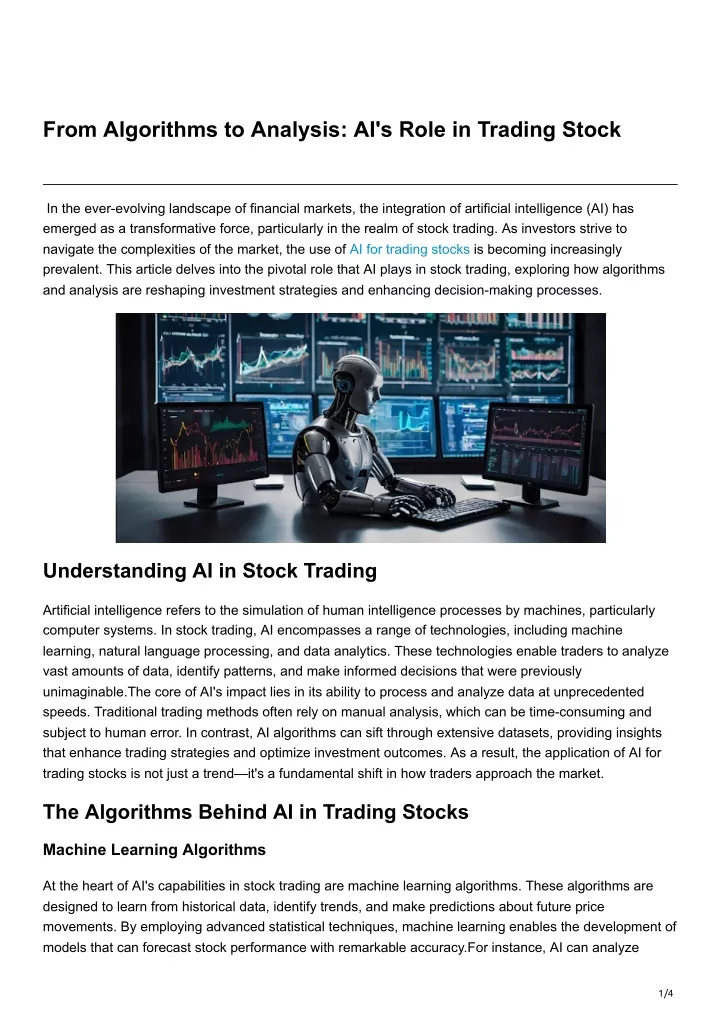Since they handle sensitive personal and financial information, security and privacy are of paramount importance when using AI trading platforms that forecast or analyze the prices of stocks. An unauthorized breach of data or misuse of data can result in financial losses and reputational damage. Here are 10 top guidelines to determine the security and privacy of these platforms.
1. Assess the encryption of data
Secure transmission of data: Make sure the platform uses encryption protocols that are secure (e.g., TLS/SSL) to secure data transferred between your device and the servers.
Encryption at rest: Verify that any sensitive information stored on the platform's servers is secured with strong encryption standards (e.g. AES-256, e.g.).
End-to-end encryption: Determine that your platform has encryption from beginning to finish for communications and data that are highly sensitive.
2. Review Authentication Mechanisms
Two-factor authentication (copyright). It is important to ensure that your platform allows copyright. This will add an additional layer of security.
Biometric authentication: Determine whether the app supports biometric login methods (e.g., fingerprints or facial recognition) for mobile apps.
Password policies. Check if the platform is enforcing policies on passwords that are secure (e.g., length minimum or complexity requirements).
3. Verify Compliance
Financial regulations: Ensure that your platform complies the relevant laws governing financial transactions (e.g. SEC FINRA MiFID II).
Laws on data protection: Check for compliance with privacy laws (e.g. GDPR, GDPR CCPA) when you're operating in or trading with areas covered by these laws.
Audit certifications - Check to see if the system is accredited or has been subject to third party security audits (e.g. SOC 2, ISO 27001).
Review Controls for Access to Data
Role-based access: Ensure the platform has access control based on role (RBAC) to limit data access to authorized users.
Verify if you are able to create different levels of permission for users or teams.
Activity monitoring: See whether the platform records and monitors user activity to identify suspicious behaviour.
5. Examine Vulnerability Management
Regular updates: Ensure that the platform regularly updates its software to patch security holes.
Testing for penetration: Examine to find out if your platform is subjected to regular penetration tests to help it discover and rectify security flaws.
Programs for bug bounty: Check if the platform has bugs bounty programs that encourages external security researchers to disclose security holes.
6. Evaluate Data Privacy Policies
Transparency: Read the privacy policy of the platform to understand the ways in which data is collected, shared, and utilized.
Data minimization - Make sure that the platform only collects the information it requires to function.
Third-party sharing: Check if the platform shares data with third parties and, if it does in what manner.
7. Secure API usage is detected
API security: Verify that the platform's API utilizes secure authentication (e.g. OAuth, API Keys) and encrypts every data exchange.
Rate limits: Check if the API has rate limitations to stop brute-force attacks or abuse.
Examine the access logs to determine if they're being monitored and audited for compliance.
8. Review the Recovery and Response to Incidents
Plan for incident response The platform has an effective strategy to deal with data breaches and security incidents.
Notification policies: Check if users are informed promptly in case of a security breach.
Make sure you have backups of data as well as disaster recovery plans.
9. Review physical security measures
Data center security Check that the servers on your platform are situated in data centers that have physical security measures such as security and access controls.
Redundancy: Determine whether the platform is equipped with redundant systems in order to guarantee the availability of data in the event an hardware failure.
Examine the geographical distribution of data to ensure resilience.
10. Check the privacy settings of your users
Data deletion. Be sure to permanently delete data from the platform when you end your use of the service.
Privacy settings - Examine to determine if the platform permits users to set privacy settings in order for you to control what data will be shared or visible.
Verify that the platform is anonymized. This is important if you are using the platform to perform analytics or machine-learning.
Bonus Tips
Review and feedback of users to evaluate the platform's security and privacy.
Trial time: You can avail a demo or a free trial to test out the privacy and security controls.
Customer Support: Be sure that the platform provides solid assistance for any problems or issues related to security.
Following these tips can aid you in assessing the security and privacy features of AI platform for predicting and analyzing stocks. This will ensure that your financial and personal information is secure. A secure platform safeguards your investments and creates trust in its services. See the top rated ai stock picker for more recommendations including ai trading, ai for trading, investment ai, best ai for trading, stock ai, ai stock picker, trading ai, ai investing app, ai for stock trading, investing ai and more.

Top 10 Tips To Evaluate The Social And Community Aspects In Ai Stock-Predicting And Analyzing Platforms
To understand how users learn, interact, and share their knowledge among themselves, it's important to evaluate the social and community-based features of AI trading and stock prediction platforms. These features can significantly enhance the user experience as well as provide important assistance. These are 10 top ways to assess the social and community aspects of these platforms:
1. Active User Group
Tip: Ensure the platform is actively used and has users who are regularly engaged in discussions, sharing their insights or giving feedback.
Why: A lively community is a place where users can grow and learn together.
2. Discussion forums and boards
You can determine the credibility of an online discussion forum or message board by looking at the activity levels.
Why: Forums are a great way for users to share ideas, discuss trends, and ask questions.
3. Social Media Integration
Tip: Assess whether the platform is integrated with social media platforms (e.g., Twitter, LinkedIn) for sharing insights and news.
Why social media integration can increase engagement and provide current market updates in real time.
4. User-Generated Materials
Look for features that enable users to share, create, and modify content.
Why: User-generated material fosters collaboration, and it provides different perspectives.
5. Expert Contributions
Tips: Check for contributions from industry experts such as AI experts or market analysts.
Why? Expert insight adds credibility and depth to the community discussions.
6. Real-time Chat and Messaging
Tips: Ensure that you can instantly communicate between users by taking a look at the live chat and messaging options.
Reason: Real-time interaction allows quick information sharing and collaboration.
7. Community Moderation and Support
TIP: Assess the moderated and support within your local community.
Why? Effective moderation helps to create a positive and respectful atmosphere. Support is always available to help resolve problems quickly.
8. Webinars and Events
Tip - Check to see whether the platform allows live Q&A with experts, webinars, and other events.
The reason: These events provide opportunities for direct interaction and learning with industry professionals.
9. User Reviews and Feedback
TIP: Find features that allow users to leave feedback or reviews about the platform and its community features.
How do we use feedback from users to identify strengths in the community ecosystem and areas of improvement.
10. Rewards and Gamification
Tip - Check to see whether your platform supports the ability to gamify (e.g. badges, leaderboards) or rewards that are given to those who participate.
Gamification encourages users and community members to become more involved.
Bonus tip: Privacy and security
Check that the community features and social features have robust privacy and security measures to guard user information and their interactions.
You can evaluate these features to find out if the AI trading and stock prediction platform provides a community that is supportive and engages you in trading. Follow the recommended see page about ai investment tools for site recommendations including chart ai trading, how to use ai for stock trading, chart analysis ai, best ai stocks, can ai predict stock market, stock predictor, ai trading tool, chart ai trading, best ai trading platform, ai for trading stocks and more.
